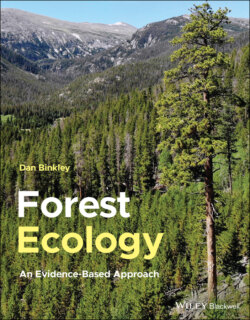Читать книгу Forest Ecology - Dan Binkley - Страница 45
Events and Interactions Are More Important Than Averages and Single Factors
ОглавлениеFor learning purposes, it may be reasonable to talk about patterns and processes of energy, temperature, water and wind separately. Forests are influenced and respond to all of these all at once, with complex interactions that have legacies that can last for centuries. We can enter a forest and look around, employing knowledge and measurements to understand what's going on currently in the forest, including temperatures, water use by trees, and connections with growth. The current composition and structure of the forest resulted from a legacy of environmental factors in the past, especially the big events of storms, fires, and insect outbreaks. These historical events often leave traces that can be unearthed with careful study. The future of any forest will depend on the current operations of environmental factors, on the historical legacies of past major events, and on big events that may or may not happen soon. Any forest can be examined with these three questions (what's up with this forest, how did it get that way, and what's next?), but the answers always require an inconvenient amount of local detail. And when it comes to “what's next?”, only broad, hazy insights are possible because big events just can't be predicted with much clarity.
FIGURE 2.21 What will happen in this forest on a windy day in June? Back in 1928, the forest was a mosaic of trees within a matrix of small grassy meadows
(Source: photo by H. Krauch, US Forest Service photo 16974A).
A partially logged forest would require a windstorm of over 200 km hr−1 for a fire to spread from crown to crown across the forest (which might be strong enough to topple the trees). With heavy cattle grazing and fire suppression for eight decades, the grass meadow matrix was replaced by a high density of closely packed trees (white arrow points to the same rock;
Source: photo by Andrew Sanchez‐Meador),
and a wind of only 50 km hr−1 could spread a crown fire. For a related, spatially explicit example, see Figure 11.14.
(Source: D.W. Huffman, J.D. Bakker, D.M. Bell, and M.M. Moore, unpublished).
